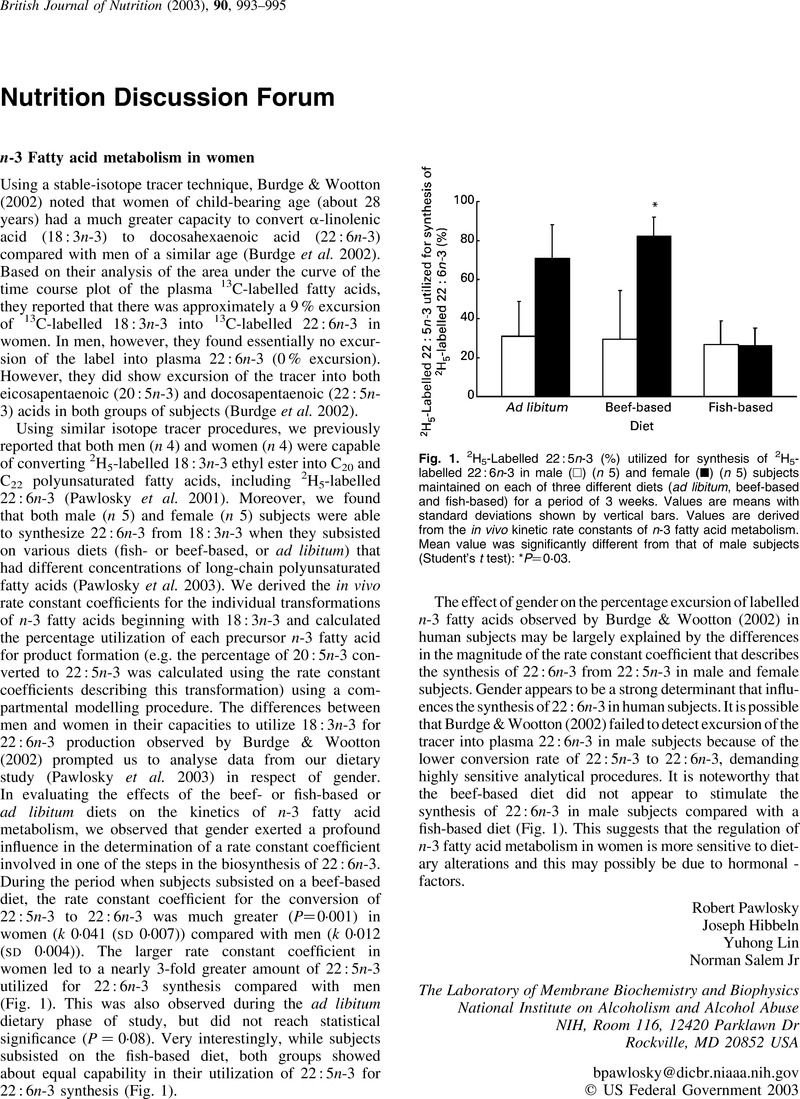Crossref Citations
This article has been cited by the following publications. This list is generated based on data provided by Crossref.
Burdge, Graham
2003.
n-3 Fatty acid metabolism in women – Reply.
British Journal of Nutrition,
Vol. 90,
Issue. 5,
p.
994.
Ghebremeskel, Kebreab
Thomas, Beverley
Lowy, Clara
Min, Yoeju
and
Crawford, Michael A.
2004.
Type 1 diabetes compromises plasma arachidonic and docosahexaenoic acids in newborn babies.
Lipids,
Vol. 39,
Issue. 4,
p.
335.
Payet, Marianne
Esmail, Mohamed H.
Polichetti, Elisabeth
Le Brun, Gaël
Adjemout, Lounès
Donnarel, Gérard
Portugal, Henri
and
Pieroni, Gérard
2004.
Docosahexaenoic acid-enriched egg consumption induces accretion of arachidonic acid in erythrocytes of elderly patients.
British Journal of Nutrition,
Vol. 91,
Issue. 5,
p.
789.
Stark, Ken D.
Beblo, Skadi
Murthy, Mahadev
Buda-Abela, Michelle
Janisse, James
Rockett, Helaine
Whitty, Janice E.
Martier, Susan S.
Sokol, Robert J.
Hannigan, John H.
and
Salem, Norman
2005.
Comparison of bloodstream fatty acid composition from African-American women at gestation, delivery, and postpartum.
Journal of Lipid Research,
Vol. 46,
Issue. 3,
p.
516.
Denomme, Jennifer
Stark, Ken D.
and
Holub, Bruce J.
2005.
Directly Quantitated Dietary (n-3) Fatty Acid Intakes of Pregnant Canadian Women Are Lower than Current Dietary Recommendations.
The Journal of Nutrition,
Vol. 135,
Issue. 2,
p.
206.
Burdge, Graham C.
and
Calder, Philip C.
2005.
α‐Linolenic acid metabolism in adult humans: the effects of gender and age on conversion to longer‐chain polyunsaturated fatty acids.
European Journal of Lipid Science and Technology,
Vol. 107,
Issue. 6,
p.
426.
Thomas, B.A.
Ghebremeskel, Kebreab
Lowy, Clara
Offley-Shore, Brigid
and
Crawford, Michael A.
2005.
Plasma fatty acids of neonates born to mothers with and without gestational diabetes.
Prostaglandins, Leukotrienes and Essential Fatty Acids,
Vol. 72,
Issue. 5,
p.
335.
Bakewell, Lucy
Burdge, Graham C.
and
Calder, Philip C.
2006.
Polyunsaturated fatty acid concentrations in young men and women consuming their habitual diets.
British Journal of Nutrition,
Vol. 96,
Issue. 01,
p.
93.
Williams, Christine M.
and
Burdge, Graham
2006.
Long-chainn−3 PUFA: plantv. marine sources.
Proceedings of the Nutrition Society,
Vol. 65,
Issue. 1,
p.
42.
Langdon, John H.
2006.
Has an aquatic diet been necessary for hominin brain evolution and functional development?.
British Journal of Nutrition,
Vol. 96,
Issue. 01,
p.
7.
Burdge, Graham C
and
Calder, Philip C
2006.
Dietary α-linolenic acid and health-related outcomes: a metabolic perspective.
Nutrition Research Reviews,
Vol. 19,
Issue. 1,
p.
26.
Welch, Ailsa A
Bingham, Sheila A
Ive, Jessica
Friesen, Marlin D
Wareham, Nick J
Riboli, Elio
and
Khaw, KT
2006.
Dietary fish intake and plasma phospholipid n–3 polyunsaturated fatty acid concentrations in men and women in the European Prospective Investigation into Cancer–Norfolk United Kingdom cohort.
The American Journal of Clinical Nutrition,
Vol. 84,
Issue. 6,
p.
1330.
Burdge, G.C.
2006.
Metabolism of α-linolenic acid in humans.
Prostaglandins, Leukotrienes and Essential Fatty Acids,
Vol. 75,
Issue. 3,
p.
161.
Kusumoto, Aki
Ishikura, Yoshiyuki
Kawashima, Hiroshi
Kiso, Yoshinobu
Takai, Shinji
and
Miyazaki, Mizuo
2007.
Effects of arachidonate-enriched triacylglycerol supplementation on serum fatty acids and platelet aggregation in healthy male subjects with a fish diet.
British Journal of Nutrition,
Vol. 98,
Issue. 3,
p.
626.
Lindqvist, H
Langkilde, A M
Undeland, I
Rådendal, T
and
Sandberg, A S
2007.
Herring (Clupea harengus) supplemented diet influences risk factors for CVD in overweight subjects.
European Journal of Clinical Nutrition,
Vol. 61,
Issue. 9,
p.
1106.
Crowe, Francesca L.
Murray Skeaff, C.
Green, Timothy J.
and
Gray, Andrew R.
2008.
Serumn-3 long-chain PUFA differ by sex and age in a population-based survey of New Zealand adolescents and adults.
British Journal of Nutrition,
Vol. 99,
Issue. 1,
p.
168.
Ylönen, S K
Salminen, I
Lyssenko, V
Virtanen, S M
Groop, L
Aro, A
and
Saloranta, C
2008.
The Pro12Ala polymorphism of the PPAR-γ2 gene affects associations of fish intake and marine n−3 fatty acids with glucose metabolism.
European Journal of Clinical Nutrition,
Vol. 62,
Issue. 12,
p.
1432.
Hodson, Leanne
Skeaff, C. Murray
and
Fielding, Barbara A.
2008.
Fatty acid composition of adipose tissue and blood in humans and its use as a biomarker of dietary intake.
Progress in Lipid Research,
Vol. 47,
Issue. 5,
p.
348.
Childs, Caroline E.
Romeu-Nadal, Meritxell
Burdge, Graham C.
and
Calder, Philip C.
2008.
Gender differences in then-3 fatty acid content of tissues.
Proceedings of the Nutrition Society,
Vol. 67,
Issue. 1,
p.
19.
Burdge, G.C.
Slater-Jefferies, J.L.
Grant, R.A.
Chung, W.-S.
West, A.L.
Lillycrop, K.A.
Hanson, M.A.
and
Calder, P.C.
2008.
Sex, but not maternal protein or folic acid intake, determines the fatty acid composition of hepatic phospholipids, but not of triacylglycerol, in adult rats.
Prostaglandins, Leukotrienes and Essential Fatty Acids,
Vol. 78,
Issue. 1,
p.
73.



